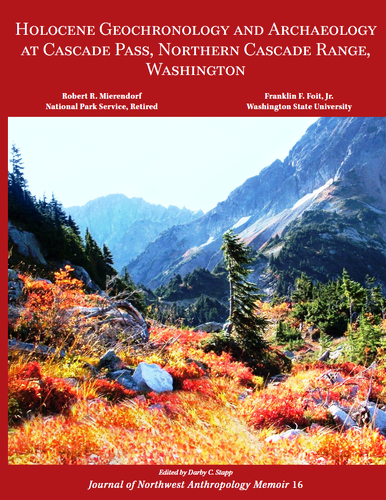Holocene Geochronology and Archaeology at Cascade Pass, Northern Cascade Range, WA
By Robert R. Mierendorf, National Park Service
and Franklin F. Foit, Jr., WSU
By Robert R. Mierendorf, National Park Service
and Franklin F. Foit, Jr., WSU
Indigenous uses of Cascade Pass began by about 9,600 years ago and continues through the present. Cascade Pass is one of many on the northern Cascade Range divide that separates east-flowing from west-flowing rivers (to the Columbia River and Salish Sea, respectively). In the Lushootseed language of Skagit people, Cascade Pass is ᶎʔlu’s which translates as “over the mountain”. Cascade Pass’ traditional importance is further recorded in ethnographic and historic accounts of Salish elders from villages on both sides of the range (Northwest Coast and Plateau culture areas). It became one of the first trans-Cascade routes explored in the contact period and later the area attracted prospectors, photographers, road planners, hikers and campers, and climbers.
In response to overuse from the burgeoning popularity of camping in the Pass meadows, the eroded soils of the early 1970s have been largely returned to native meadow plants. Beginning in 2005, Park archaeologists conducted limited excavations to gather baseline data and determine the significance of the archaeological remains recorded in 1977 as archaeological site 45CH221.
This presentation describes the technical results of the excavations and more generally, the way these contribute to understanding how the site formed (site formation processes) and its state of preservation (taphonomy), how it was used for over nine millennia, and what this new data means in light of current understandings of Pacific Northwest peoples’ traditional occupation of alpine areas in the larger region, and to broader research and conservation issues.
In response to overuse from the burgeoning popularity of camping in the Pass meadows, the eroded soils of the early 1970s have been largely returned to native meadow plants. Beginning in 2005, Park archaeologists conducted limited excavations to gather baseline data and determine the significance of the archaeological remains recorded in 1977 as archaeological site 45CH221.
This presentation describes the technical results of the excavations and more generally, the way these contribute to understanding how the site formed (site formation processes) and its state of preservation (taphonomy), how it was used for over nine millennia, and what this new data means in light of current understandings of Pacific Northwest peoples’ traditional occupation of alpine areas in the larger region, and to broader research and conservation issues.
DATE: Friday, May 17th, 2019
TIME: 7 pm to 9 pm
PLACE: Mountaineers Seattle Program Center, 7700 Sand Point Way NE, Seattle, WA 98115 in the Cascade Room
COST: FREE to members, $10.00 to non-members, $5.00 for Students (please renew membership for 2019 and these programs at http://www.pnwas.org and now through PayPal)
Refreshments provided (Please bring cookies/snacks to share with the beverages).
TIME: 7 pm to 9 pm
PLACE: Mountaineers Seattle Program Center, 7700 Sand Point Way NE, Seattle, WA 98115 in the Cascade Room
COST: FREE to members, $10.00 to non-members, $5.00 for Students (please renew membership for 2019 and these programs at http://www.pnwas.org and now through PayPal)
Refreshments provided (Please bring cookies/snacks to share with the beverages).

 RSS Feed
RSS Feed
